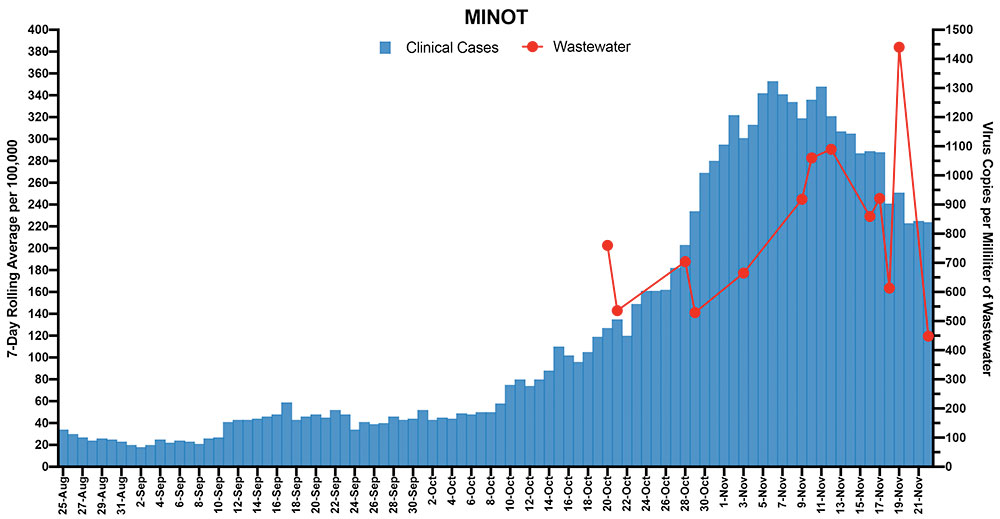Minot participates in state wastewater testing for COVID-19
Minot participates in statewide research on virus spread

Submitted Photo A collection container of wastewater from a Minot lift station is ready to be shipped for testing for COVID-19.
Looking for more clues regarding the spread of COVID-19 in North Dakota, researchers at North Dakota State University are working with state health officials to test for the virus in wastewater samples from multiple communities, including Minot.
City of Minot workers take samples at two of the city’s largest lift stations – the master lift station that includes much of the main, older portion of Minot, including the hospital, and the 55th Street lift station in southeast Minot. Minot has been sampling wastewater two days a week, although NDSU processed samples from four days of Minot collections during a recent week.
Wastewater from throughout a wide area comes together in a lift station, and samples are drawn from this pooled collection. No samples can be traced to particular neighborhoods, private residences or businesses.
Generally, COVID-19 counts in samples from the master lift station have been higher than in samples from the 55th Street lift station, said researcher John McEvoy, head of the NDSU Microbiological Sciences Department. That difference began to narrow in mid-November. Both sites have shown increased viral counts, but counts have risen at the 55th Street station to largely match those at the master station. Both locations also saw a drop in counts this past week.
McEvoy said tracking the fluctuations of the virus over time can inform scientists seeking to learn more about the virus.

Submitted Photo This chart from the Microbiological Sciences Department at North Dakota State University shows how COVID-19 detected in wastewater from Minot’s master lift station compares with the rolling seven-day average per 100,000 population from positive human tests in Minot.
“The thing about wastewater testing that’s different than human testing is wastewater measures everybody that’s contributing to the wastewater, whether symptomatic, asymptomatic or pre-symptomatic,” McEvoy said. “Once we get this under control more, this will be a great way of monitoring levels in the community so that if, for some reason, they start to come up again, we can do something about it.”
Monitoring wastewater can be less expensive and less intrusive than testing large numbers of individuals for the purpose of monitoring the virus. Increases in the virus count in wastewater also can precede increases in positive human tests in the population as people shed the virus before showing clinical signs, McEvoy said.
Some of the research showing early virus shedding comes from the North Dakota State Penitentiary, which has been collecting wastewater samples and also regularly tests inmates and staff. Clinical data is compared with wastewater data to look for correlations, McEvoy said.
“It’s too early to say anything with certainty, but we certainly were able to see the numbers in wastewater come up before the clinical cases were actually identified. We also were able to see how the numbers spike in wastewater early on and then they drop down a little bit,” he said.
The results, as they are further refined and studied, could provide information on when in the course of an illness people are most likely to shed the virus and be contagious, he said.
Minot Mayor Shaun Sipma said the research may be more useful to public health and medical personnel than to the city, which is unlikely to make policy decisions based on the data. However, wastewater sample results could provide information on asymptomatic cases, he said.
“The symptomatic we have a pretty good handle on,” he said. “The sampling is meant to give us an idea of asymptomatic cases.”
He added the wastewater samples for the COVID-19 research are among various other samples taken regularly by the city for testing to ensure compliance with environmental and health regulations.
The COVID-19 research project is supported by grant funds through the North Dakota Department of Environmental Quality and North Dakota Department of Health. The Department of Environmental Quality asked NDSU last June to conduct wastewater testing for COVID-19. Associate professor Wei Lin in NDSU’s Civil and Environmental Engineering Department also has worked with the microbiology department on the collection logistics. Initially, the research focused on Fargo, Grand Forks and Bismarck.
Using CARES Act funding, the project later expanded to between 20 and 30 other locations, adding Minot on Oct. 22, McEvoy said. The state pays for the collection containers and overnight shipping.
Some participating locations collect grab samples, which provide point-in-time information. Minot collects composite samples using automated equipment that periodically grabs samples throughout the day and includes them in a single container of 250 milliliters, about 8.5 ounces.
“A composite sample is ideal because it samples over a 24-hour period so it gives you a much better reflection of what’s going on in the city,” McEvoy said.
McEvoy explained the procedure for testing a sample begins with spinning the wastewater in a centrifuge to remove particulates. The remaining liquid is passed through a membrane, to which the virus clings. The virus’s genetic information on this small, one-inch diameter membrane is amplified in a laboratory, much like it is amplified for detection in a lab that tests human samples. The virus is measured per milliliter of wastewater.
McEvoy said the research is likely to continue as long as COVID-19 remains a concern in the state.
- Submitted Photo A collection container of wastewater from a Minot lift station is ready to be shipped for testing for COVID-19.
- Submitted Photo This chart from the Microbiological Sciences Department at North Dakota State University shows how COVID-19 detected in wastewater from Minot’s master lift station compares with the rolling seven-day average per 100,000 population from positive human tests in Minot.



